International Trade : Theory and Policy Lecture 11

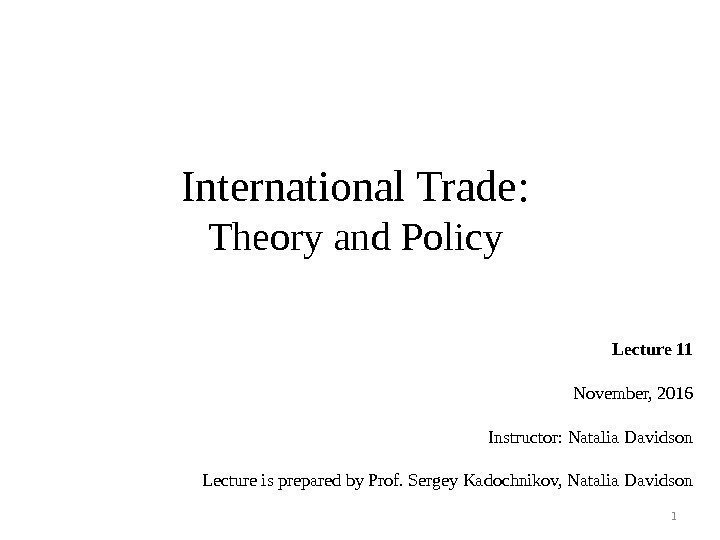
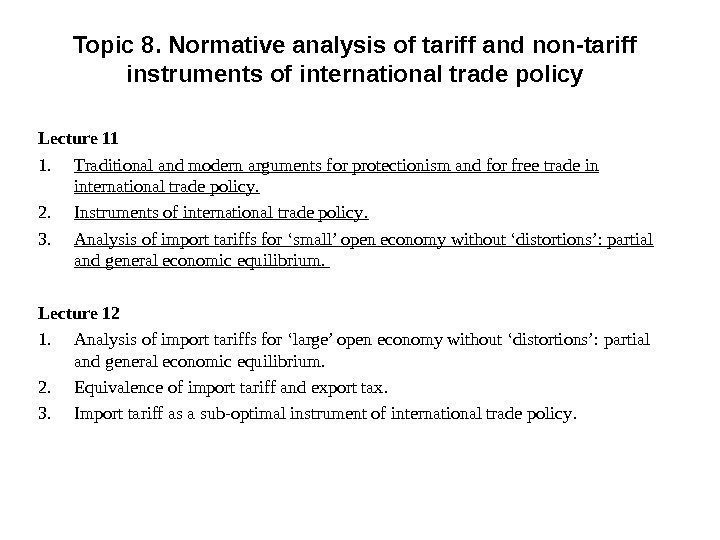
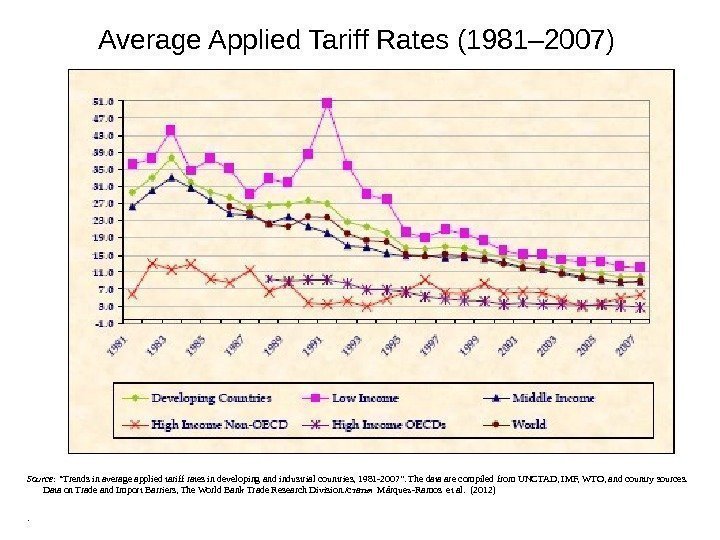
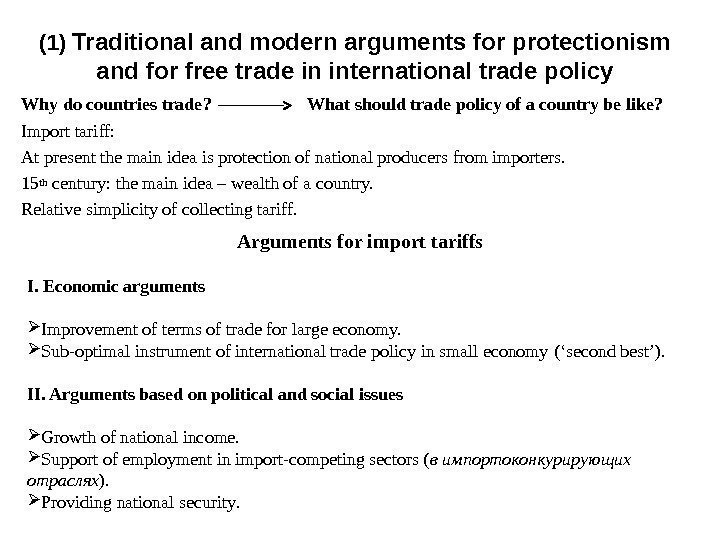
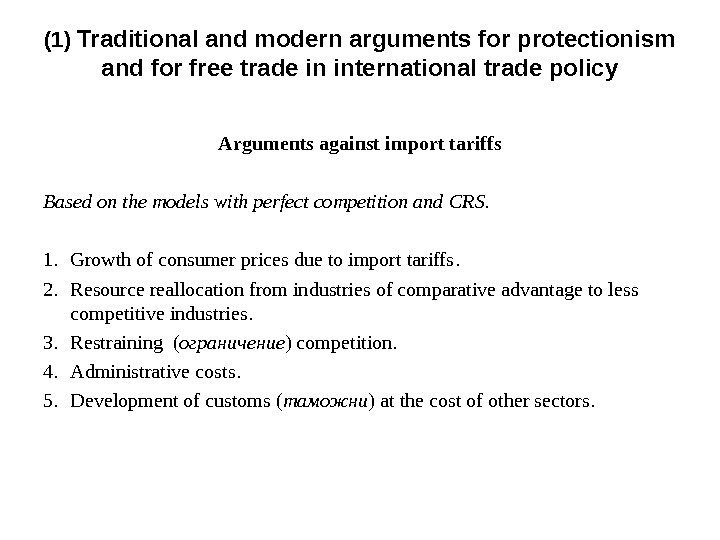
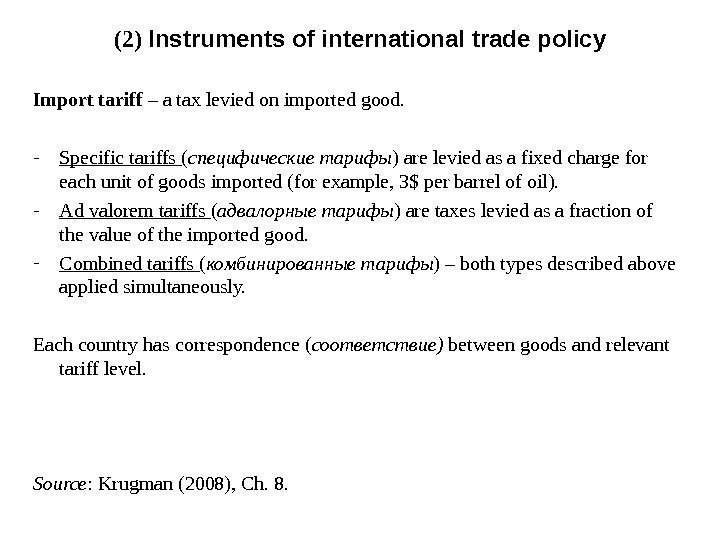
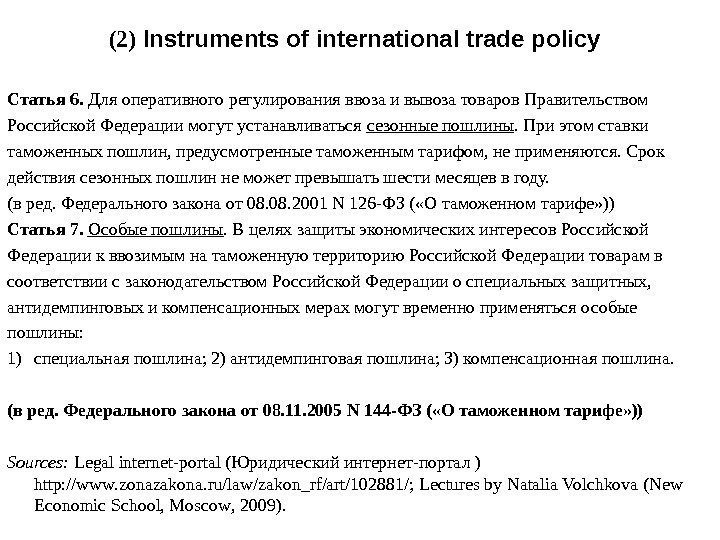
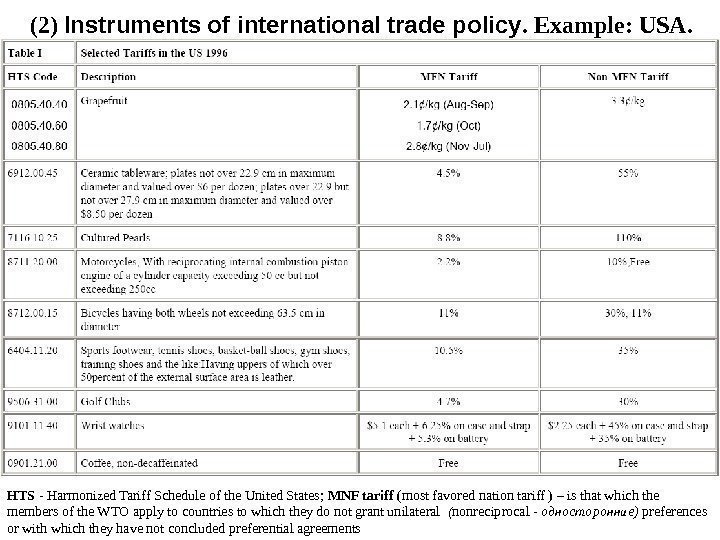
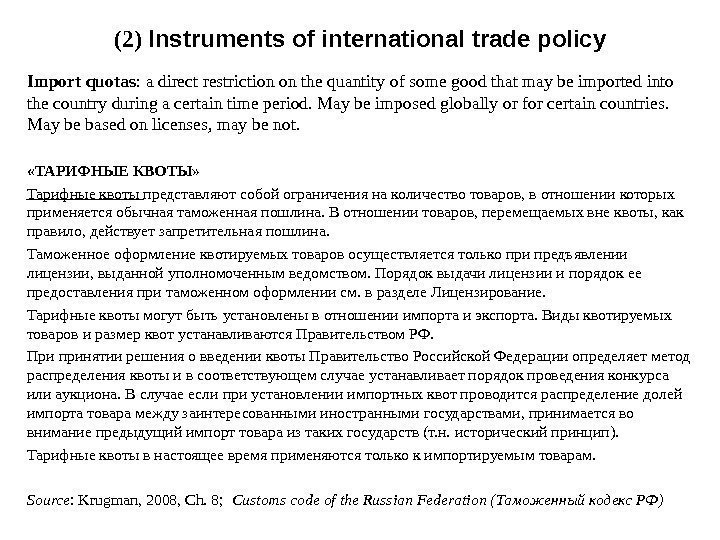

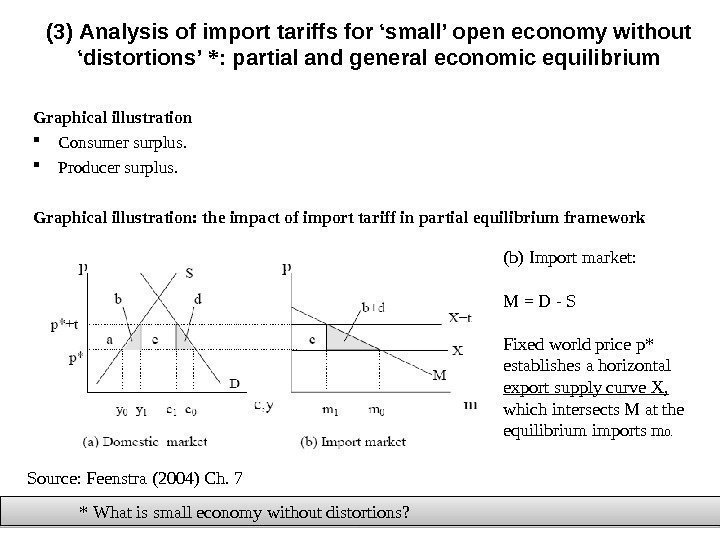
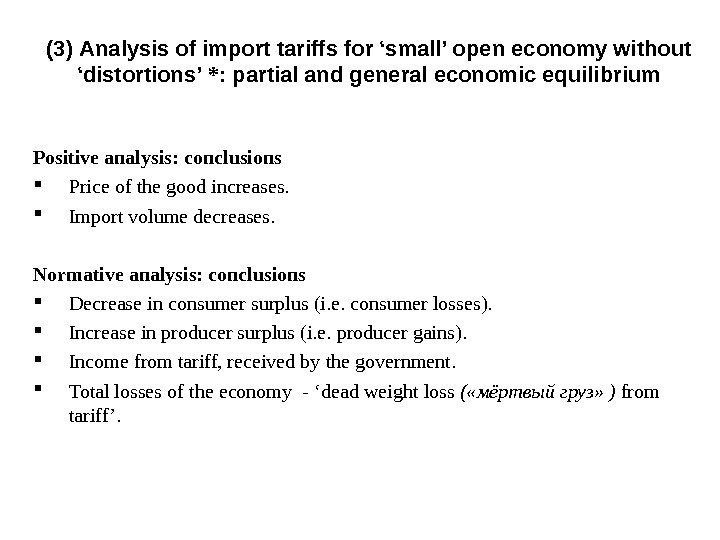
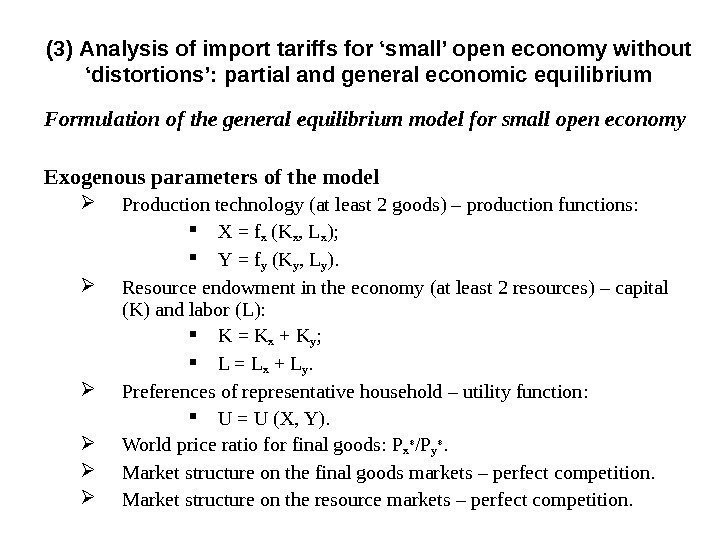
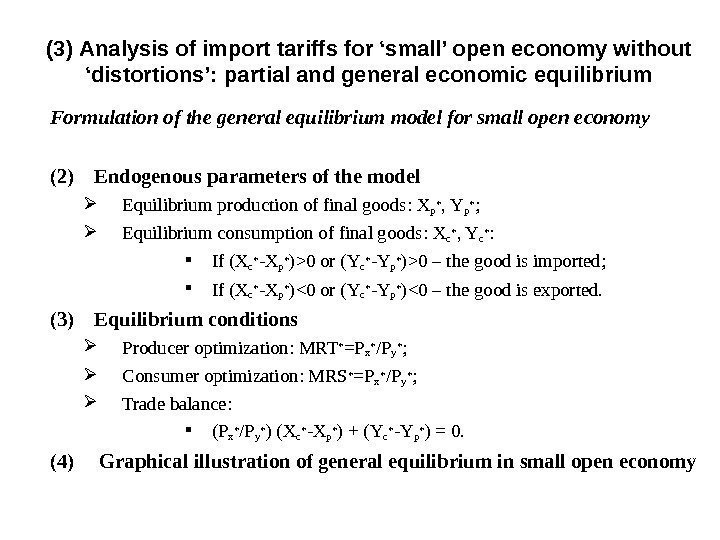
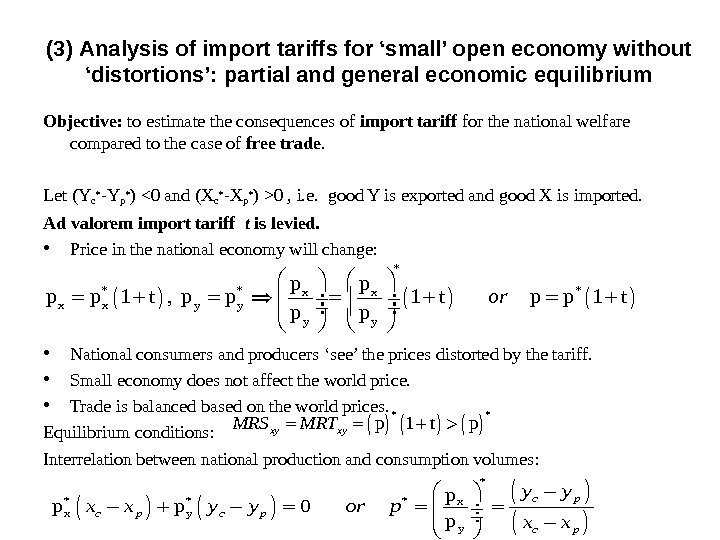
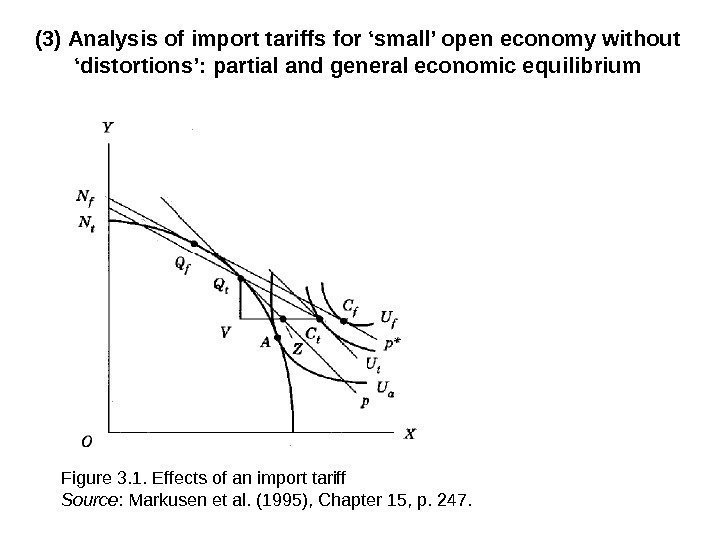
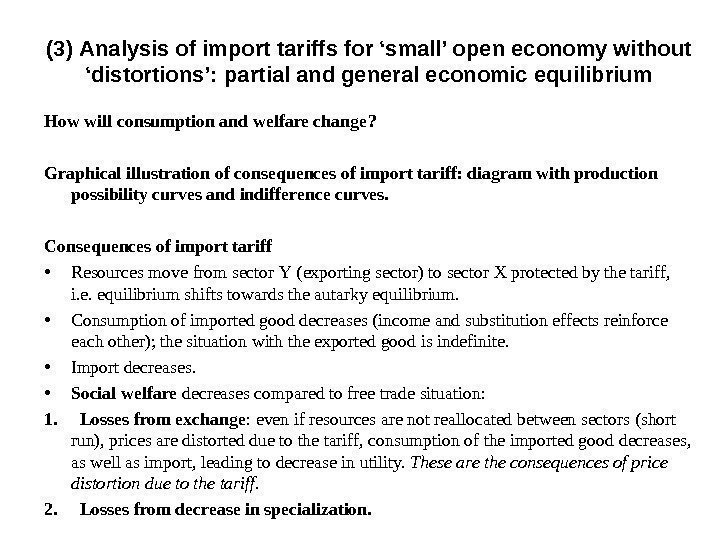
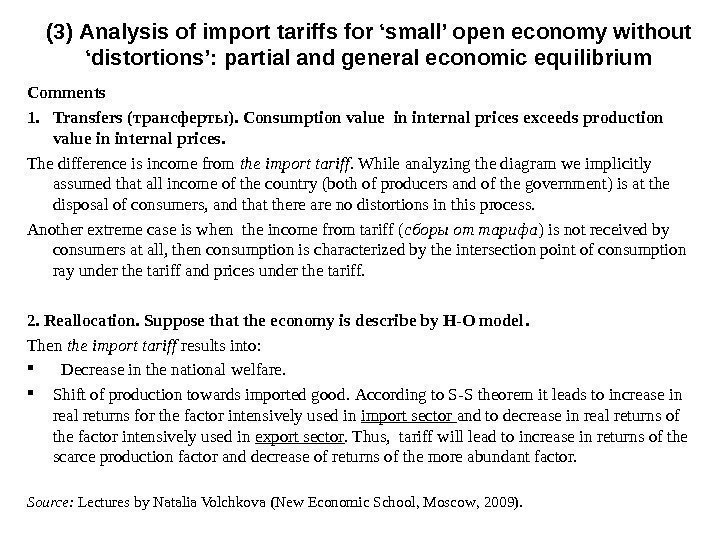
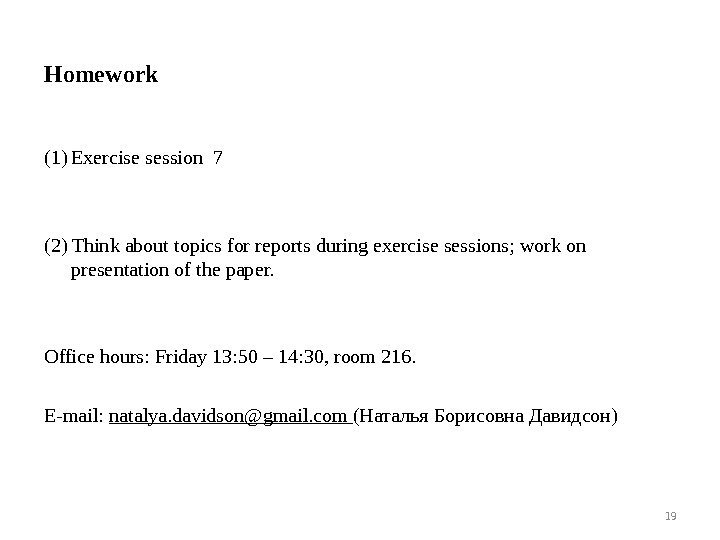
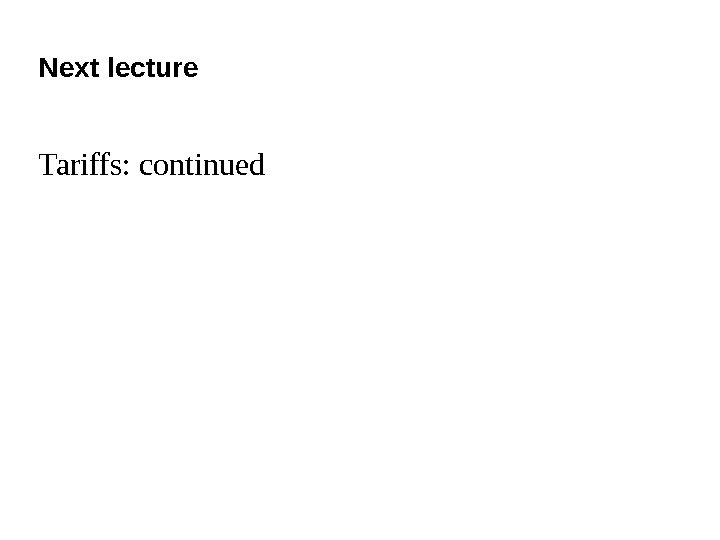
itt-autumn-2016-lecture-11-e.ppt
- Размер: 425.5 Кб
- Автор:
- Количество слайдов: 20
Описание презентации International Trade : Theory and Policy Lecture 11 по слайдам
 International Trade : Theory and Policy Lecture 11 November, 2016 Instructor: Natalia Davidson Lecture is prepared by Prof. Sergey Kadochnikov, Natalia Davidson
International Trade : Theory and Policy Lecture 11 November, 2016 Instructor: Natalia Davidson Lecture is prepared by Prof. Sergey Kadochnikov, Natalia Davidson
 Topic 8. Normative analysis of tariff and non-tariff instruments of international trade policy Lecture 11 1. Traditional and modern arguments for protectionism and for free trade in international trade policy. 2. Instruments of international trade policy. 3. Analysis of import tariffs for ‘small’ open economy without ‘distortions’: partial and general economic equilibrium. Lecture 12 1. Analysis of import tariffs for ‘large’ open economy without ‘distortions’: partial and general economic equilibrium. 2. Equivalence of import tariff and export tax. 3. Import tariff as a sub-optimal instrument of international trade policy.
Topic 8. Normative analysis of tariff and non-tariff instruments of international trade policy Lecture 11 1. Traditional and modern arguments for protectionism and for free trade in international trade policy. 2. Instruments of international trade policy. 3. Analysis of import tariffs for ‘small’ open economy without ‘distortions’: partial and general economic equilibrium. Lecture 12 1. Analysis of import tariffs for ‘large’ open economy without ‘distortions’: partial and general economic equilibrium. 2. Equivalence of import tariff and export tax. 3. Import tariff as a sub-optimal instrument of international trade policy.
 Average Applied Tariff Rates (1981– 2007) Source : “Trends in average applied tariff rates in developing and industrial countries, 1981 -2007”. The data are compiled from UNCTAD, IMF, WTO, and country sources. Data on Trade and Import Barriers, The World Bank Trade Research Division. /статья Márquez-Ramos et al. (2012).
Average Applied Tariff Rates (1981– 2007) Source : “Trends in average applied tariff rates in developing and industrial countries, 1981 -2007”. The data are compiled from UNCTAD, IMF, WTO, and country sources. Data on Trade and Import Barriers, The World Bank Trade Research Division. /статья Márquez-Ramos et al. (2012).
 (1) Traditional and modern arguments for protectionism and for free trade in international trade policy Why do countries trade ? What should trade policy of a country be like ? Import tariff : At present the main idea is protection of national producers from importers. 15 th century : the main idea – wealth of a country. Relative simplicity of collecting tariff. Arguments for import tariffs I. Economic arguments Improvement of terms of trade for large economy. Sub-optimal instrument of international trade policy in small economy ( ‘second best’). II. Arguments based on political and social issues Growth of national income. Support of employment in import-competing sectors ( в импортоконкурирующих отраслях ). Providing national security.
(1) Traditional and modern arguments for protectionism and for free trade in international trade policy Why do countries trade ? What should trade policy of a country be like ? Import tariff : At present the main idea is protection of national producers from importers. 15 th century : the main idea – wealth of a country. Relative simplicity of collecting tariff. Arguments for import tariffs I. Economic arguments Improvement of terms of trade for large economy. Sub-optimal instrument of international trade policy in small economy ( ‘second best’). II. Arguments based on political and social issues Growth of national income. Support of employment in import-competing sectors ( в импортоконкурирующих отраслях ). Providing national security.
 Arguments against import tariffs Based on the models with perfect competition and CRS. 1. Growth of consumer prices due to import tariffs. 2. Resource reallocation from industries of comparative advantage to less competitive industries. 3. Restraining ( ограничение ) competition. 4. Administrative costs. 5. Development of customs ( таможни ) at the cost of other sectors. (1) Traditional and modern arguments for protectionism and for free trade in international trade policy
Arguments against import tariffs Based on the models with perfect competition and CRS. 1. Growth of consumer prices due to import tariffs. 2. Resource reallocation from industries of comparative advantage to less competitive industries. 3. Restraining ( ограничение ) competition. 4. Administrative costs. 5. Development of customs ( таможни ) at the cost of other sectors. (1) Traditional and modern arguments for protectionism and for free trade in international trade policy
 (2) Instruments of international trade policy Import tariff – a tax levied on imported good. — Specific tariffs ( специфические тарифы ) are levied as a fixed charge for each unit of goods imported (for example, 3$ per barrel of oil). — Ad valorem tariffs ( адвалорные тарифы ) are taxes levied as a fraction of the value of the imported good. — Combined tariffs ( комбинированные тарифы ) – both types described above applied simultaneously. Each country has correspondence ( соответствие ) between goods and relevant tariff level. Source : Krugman (2008), Ch. 8.
(2) Instruments of international trade policy Import tariff – a tax levied on imported good. — Specific tariffs ( специфические тарифы ) are levied as a fixed charge for each unit of goods imported (for example, 3$ per barrel of oil). — Ad valorem tariffs ( адвалорные тарифы ) are taxes levied as a fraction of the value of the imported good. — Combined tariffs ( комбинированные тарифы ) – both types described above applied simultaneously. Each country has correspondence ( соответствие ) between goods and relevant tariff level. Source : Krugman (2008), Ch. 8.
 (2) Instruments of international trade policy Статья 6. Для оперативного регулирования ввоза и вывоза товаров Правительством Российской Федерации могут устанавливаться сезонные пошлины. При этом ставки таможенных пошлин, предусмотренные таможенным тарифом, не применяются. Срок действия сезонных пошлин не может превышать шести месяцев в году. (в ред. Федерального закона от 08. 2001 N 126 -ФЗ ( «О таможенном тарифе» )) Статья 7. Особые пошлины. В целях защиты экономических интересов Российской Федерации к ввозимым на таможенную территорию Российской Федерации товарам в соответствии с законодательством Российской Федерации о специальных защитных, антидемпинговых и компенсационных мерах могут временно применяться особые пошлины: 1) специальная пошлина; 2) антидемпинговая пошлина; 3) компенсационная пошлина. (в ред. Федерального закона от 08. 11. 2005 N 144 -ФЗ ( «О таможенном тарифе» )) Sources : Legal internet-portal ( Юридический интернет-портал ) http: //www. zonazakona. ru/law/zakon_rf/art/102881/ ; Lectures by Natalia Volchkova ( New Economic School, Moscow , 2 009).
(2) Instruments of international trade policy Статья 6. Для оперативного регулирования ввоза и вывоза товаров Правительством Российской Федерации могут устанавливаться сезонные пошлины. При этом ставки таможенных пошлин, предусмотренные таможенным тарифом, не применяются. Срок действия сезонных пошлин не может превышать шести месяцев в году. (в ред. Федерального закона от 08. 2001 N 126 -ФЗ ( «О таможенном тарифе» )) Статья 7. Особые пошлины. В целях защиты экономических интересов Российской Федерации к ввозимым на таможенную территорию Российской Федерации товарам в соответствии с законодательством Российской Федерации о специальных защитных, антидемпинговых и компенсационных мерах могут временно применяться особые пошлины: 1) специальная пошлина; 2) антидемпинговая пошлина; 3) компенсационная пошлина. (в ред. Федерального закона от 08. 11. 2005 N 144 -ФЗ ( «О таможенном тарифе» )) Sources : Legal internet-portal ( Юридический интернет-портал ) http: //www. zonazakona. ru/law/zakon_rf/art/102881/ ; Lectures by Natalia Volchkova ( New Economic School, Moscow , 2 009).
 HTS — Harmonized Tariff Schedule of the United States ; MNF tariff (most favored nation tariff ) – is that which the members of the WTO apply to countries to which they do not grant unilateral ( nonreciprocal — односторонние ) preferences or with which they have not concluded preferential agreements (2) Instruments of international trade policy. Example: USA.
HTS — Harmonized Tariff Schedule of the United States ; MNF tariff (most favored nation tariff ) – is that which the members of the WTO apply to countries to which they do not grant unilateral ( nonreciprocal — односторонние ) preferences or with which they have not concluded preferential agreements (2) Instruments of international trade policy. Example: USA.
 Import quotas : a direct restriction on the quantity of some good that may be imported into the country during a certain time period. May be imposed globally or for certain countries. May be based on licenses, may be not. «ТАРИФНЫЕ КВОТЫ» Тарифные квоты представляют собой ограничения на количество товаров, в отношении которых применяется обычная таможенная пошлина. В отношении товаров, перемещаемых вне квоты, как правило, действует запретительная пошлина. Таможенное оформление квотируемых товаров осуществляется только при предъявлении лицензии, выданной уполномоченным ведомством. Порядок выдачи лицензии и порядок ее предоставления при таможенном оформлении см. в разделе Лицензирование. Тарифные квоты могут быть установлены в отношении импорта и экспорта. Виды квотируемых товаров и размер квот устанавливаются Правительством РФ. При принятии решения о введении квоты Правительство Российской Федерации определяет метод распределения квоты и в соответствующем случае устанавливает порядок проведения конкурса или аукциона. В случае если при установлении импортных квот проводится распределение долей импорта товара между заинтересованными иностранными государствами, принимается во внимание предыдущий импорт товара из таких государств (т. н. исторический принцип). Тарифные квоты в настоящее время применяются только к импортируемым товарам. Source : Krugman, 2008, Ch. 8; Customs code of the Russian Federation ( Таможенный кодекс РФ )(2) Instruments of international trade policy
Import quotas : a direct restriction on the quantity of some good that may be imported into the country during a certain time period. May be imposed globally or for certain countries. May be based on licenses, may be not. «ТАРИФНЫЕ КВОТЫ» Тарифные квоты представляют собой ограничения на количество товаров, в отношении которых применяется обычная таможенная пошлина. В отношении товаров, перемещаемых вне квоты, как правило, действует запретительная пошлина. Таможенное оформление квотируемых товаров осуществляется только при предъявлении лицензии, выданной уполномоченным ведомством. Порядок выдачи лицензии и порядок ее предоставления при таможенном оформлении см. в разделе Лицензирование. Тарифные квоты могут быть установлены в отношении импорта и экспорта. Виды квотируемых товаров и размер квот устанавливаются Правительством РФ. При принятии решения о введении квоты Правительство Российской Федерации определяет метод распределения квоты и в соответствующем случае устанавливает порядок проведения конкурса или аукциона. В случае если при установлении импортных квот проводится распределение долей импорта товара между заинтересованными иностранными государствами, принимается во внимание предыдущий импорт товара из таких государств (т. н. исторический принцип). Тарифные квоты в настоящее время применяются только к импортируемым товарам. Source : Krugman, 2008, Ch. 8; Customs code of the Russian Federation ( Таможенный кодекс РФ )(2) Instruments of international trade policy
 A voluntary export restraint or voluntary export restriction (VER , добровольное ограничение экспорта ) : is a government imposed limit on the quantity of goods that can be exported out of a country during a specified period of time. In fact, they are rarely voluntary. They are usually imposed on bilateral basis ( на двусторонней основе ). Among the most interesting examples are agreements between USA and Japan on automobile import into USA in 1981 and textile VERs. Export taxes are levied on exported good, as a rule, natural resources or agricultural products – the main exported good. In USA export taxes are banned by Constitution. Export subsidies : payments by government aimed at stimulating export of a certain good. Are often applied to agricultural products. Other measures Requirements for government purchases: a certain share of goods purchased by government must be produced by national firms. Sanitary and medical norms, imposed on imported goods. Red Tape ( бюрократические ) barriers , for example , import of a certain good only through certain customs offices ( таможенные посты ) etc. (2) Instruments of international trade policy
A voluntary export restraint or voluntary export restriction (VER , добровольное ограничение экспорта ) : is a government imposed limit on the quantity of goods that can be exported out of a country during a specified period of time. In fact, they are rarely voluntary. They are usually imposed on bilateral basis ( на двусторонней основе ). Among the most interesting examples are agreements between USA and Japan on automobile import into USA in 1981 and textile VERs. Export taxes are levied on exported good, as a rule, natural resources or agricultural products – the main exported good. In USA export taxes are banned by Constitution. Export subsidies : payments by government aimed at stimulating export of a certain good. Are often applied to agricultural products. Other measures Requirements for government purchases: a certain share of goods purchased by government must be produced by national firms. Sanitary and medical norms, imposed on imported goods. Red Tape ( бюрократические ) barriers , for example , import of a certain good only through certain customs offices ( таможенные посты ) etc. (2) Instruments of international trade policy
 (3) Analysis of import tariffs for ‘small’ open economy without ‘distortions’ * : partial and general economic equilibrium Graphical illustration Consumer surplus. Producer surplus. Graphical illustration: the impact of import tariff in partial equilibrium framework * What is small economy without distortions ? Source: Feenstra (2004) Ch. 7 (b) Import market: M = D — S Fixed world price p* establishes a horizontal export supply curve X, which intersects M at the equilibrium imports m 0.
(3) Analysis of import tariffs for ‘small’ open economy without ‘distortions’ * : partial and general economic equilibrium Graphical illustration Consumer surplus. Producer surplus. Graphical illustration: the impact of import tariff in partial equilibrium framework * What is small economy without distortions ? Source: Feenstra (2004) Ch. 7 (b) Import market: M = D — S Fixed world price p* establishes a horizontal export supply curve X, which intersects M at the equilibrium imports m 0.
 (3) Analysis of import tariffs for ‘small’ open economy without ‘distortions’ * : partial and general economic equilibrium Positive analysis : conclusions Price of the good increases. Import volume decreases. Normative analysis: conclusions Decrease in consumer surplus ( i. e. consumer losses ). Increase in producer surplus ( i. e. producer gains ). Income from tariff, received by the government. Total losses of the economy — ‘dead weight loss ( «мёртвый груз» ) from tariff ’.
(3) Analysis of import tariffs for ‘small’ open economy without ‘distortions’ * : partial and general economic equilibrium Positive analysis : conclusions Price of the good increases. Import volume decreases. Normative analysis: conclusions Decrease in consumer surplus ( i. e. consumer losses ). Increase in producer surplus ( i. e. producer gains ). Income from tariff, received by the government. Total losses of the economy — ‘dead weight loss ( «мёртвый груз» ) from tariff ’.
 Formulation of the general equilibrium model for small open economy Exogenous parameters of the model Production technology ( at least 2 goods ) – production functions : Х = f x (K x , L x ); Y = f y (K y , L y ). Resource endowment in the economy ( at least 2 resources ) – capital ( K ) and labor ( L ): K = K x + K y ; L = L x + L y. Preferences of representative household – utility function : U = U (X, Y). World price ratio for final goods: P x * / P y *. Market structure on the final goods markets – perfect competition. Market structure on the resource markets – perfect competition. (3) Analysis of import tariffs for ‘small’ open economy without ‘distortions’: partial and general economic equilibrium
Formulation of the general equilibrium model for small open economy Exogenous parameters of the model Production technology ( at least 2 goods ) – production functions : Х = f x (K x , L x ); Y = f y (K y , L y ). Resource endowment in the economy ( at least 2 resources ) – capital ( K ) and labor ( L ): K = K x + K y ; L = L x + L y. Preferences of representative household – utility function : U = U (X, Y). World price ratio for final goods: P x * / P y *. Market structure on the final goods markets – perfect competition. Market structure on the resource markets – perfect competition. (3) Analysis of import tariffs for ‘small’ open economy without ‘distortions’: partial and general economic equilibrium
 Formulation of the general equilibrium model for small open economy (2) Endogenous parameters of the model Equilibrium production of final goods: X p * , Y p * ; Equilibrium consumption of final goods : X c * , Y c * : If ( X c * — X p * ) > 0 or ( Y c * — Y p * ) > 0 – the good is imported ; If ( X c * — X p * ) < 0 or ( Y c * — Y p * ) < 0 – the good is exported. (3) Equilibrium conditions Producer optimization : MRT * =P x * / P y * ; Consumer optimization : MRS * =P x * / P y * ; Trade balance : ( P x * / P y * ) ( X c * — X p * ) + ( Y c * — Y p * ) = 0. (4) Graphical illustration of general equilibrium in small open economy(3) Analysis of import tariffs for ‘small’ open economy without ‘distortions’: partial and general economic equilibrium
Formulation of the general equilibrium model for small open economy (2) Endogenous parameters of the model Equilibrium production of final goods: X p * , Y p * ; Equilibrium consumption of final goods : X c * , Y c * : If ( X c * — X p * ) > 0 or ( Y c * — Y p * ) > 0 – the good is imported ; If ( X c * — X p * ) < 0 or ( Y c * — Y p * ) < 0 – the good is exported. (3) Equilibrium conditions Producer optimization : MRT * =P x * / P y * ; Consumer optimization : MRS * =P x * / P y * ; Trade balance : ( P x * / P y * ) ( X c * — X p * ) + ( Y c * — Y p * ) = 0. (4) Graphical illustration of general equilibrium in small open economy(3) Analysis of import tariffs for ‘small’ open economy without ‘distortions’: partial and general economic equilibrium
 Objective: to estimate the consequences of import tariff for the national welfare compared to the case of free trade. Let ( Yc* — Yp* ) 0 , i. e. good Y is exported and good X is imported. Ad valorem import tariff t is levied. • Price in the national economy will change: • National consumers and producers ‘see’ the prices distorted by the tariff. • Small economy does not affect the world price. • Trade is balanced based on the world prices. Equilibrium conditions : Interrelation between national production and consumption volumes : * *x x y y p p 1 t , p p 1 t p p or * *p 1 t p xy xy. MRS MRT * *x x y y p p p 0 p c p c p y y x x y y or p x x (3) Analysis of import tariffs for ‘small’ open economy without ‘distortions’: partial and general economic equilibrium
Objective: to estimate the consequences of import tariff for the national welfare compared to the case of free trade. Let ( Yc* — Yp* ) 0 , i. e. good Y is exported and good X is imported. Ad valorem import tariff t is levied. • Price in the national economy will change: • National consumers and producers ‘see’ the prices distorted by the tariff. • Small economy does not affect the world price. • Trade is balanced based on the world prices. Equilibrium conditions : Interrelation between national production and consumption volumes : * *x x y y p p 1 t , p p 1 t p p or * *p 1 t p xy xy. MRS MRT * *x x y y p p p 0 p c p c p y y x x y y or p x x (3) Analysis of import tariffs for ‘small’ open economy without ‘distortions’: partial and general economic equilibrium
 (3) Analysis of import tariffs for ‘small’ open economy without ‘distortions’: partial and general economic equilibrium Figure 3. 1. Effects of an import tariff Source : Markusen et al. (1995) , Chapter 15, p. 247.
(3) Analysis of import tariffs for ‘small’ open economy without ‘distortions’: partial and general economic equilibrium Figure 3. 1. Effects of an import tariff Source : Markusen et al. (1995) , Chapter 15, p. 247.
 How will consumption and welfare change ? Graphical illustration of consequences of import tariff: diagram with production possibility curves and indifference curves. Consequences of import tariff • Resources move from sector Y ( exporting sector ) to sector X protected by the tariff , i. e. equilibrium shifts towards the autarky equilibrium. • Consumption of imported good decreases (income and substitution effects reinforce each other); the situation with the exported good is indefinite. • Import decreases. • Social welfare decreases compared to free trade situation: 1. Losses from exchange : even if resources are not reallocated between sectors (short run), prices are distorted due to the tariff, consumption of the imported good decreases, as well as import, leading to decrease in utility. These are the consequences of price distortion due to the tariff. 2. Losses from decrease in specialization. (3) Analysis of import tariffs for ‘small’ open economy without ‘distortions’: partial and general economic equilibrium
How will consumption and welfare change ? Graphical illustration of consequences of import tariff: diagram with production possibility curves and indifference curves. Consequences of import tariff • Resources move from sector Y ( exporting sector ) to sector X protected by the tariff , i. e. equilibrium shifts towards the autarky equilibrium. • Consumption of imported good decreases (income and substitution effects reinforce each other); the situation with the exported good is indefinite. • Import decreases. • Social welfare decreases compared to free trade situation: 1. Losses from exchange : even if resources are not reallocated between sectors (short run), prices are distorted due to the tariff, consumption of the imported good decreases, as well as import, leading to decrease in utility. These are the consequences of price distortion due to the tariff. 2. Losses from decrease in specialization. (3) Analysis of import tariffs for ‘small’ open economy without ‘distortions’: partial and general economic equilibrium
 Comments 1. Transfers ( трансферты ). Consumption value in internal prices exceeds production value in internal prices. The difference is income from the import tariff. While analyzing the diagram we implicitly assumed that all income of the country (both of producers and of the government) is at the disposal of consumers, and that there are no distortions in this process. Another extreme case is when the income from tariff ( сборы от тарифа ) is not received by consumers at all, then consumption is characterized by the intersection point of consumption ray under the tariff and prices under the tariff. 2. Reallocation. Suppose that the economy is describe by H-O model. Then the import tariff results into : Decrease in the national welfare. Shift of production towards imported good. According to S-S theorem it leads to increase in real returns for the factor intensively used in import sector and to decrease in real returns of the factor intensively used in export sector. Thus, tariff will lead to increase in returns of the scarce production factor and decrease of returns of the more abundant factor. Source: Lectures by Natalia Volchkova ( New Economic School, Moscow , 2 009). (3) Analysis of import tariffs for ‘small’ open economy without ‘distortions’: partial and general economic equilibrium
Comments 1. Transfers ( трансферты ). Consumption value in internal prices exceeds production value in internal prices. The difference is income from the import tariff. While analyzing the diagram we implicitly assumed that all income of the country (both of producers and of the government) is at the disposal of consumers, and that there are no distortions in this process. Another extreme case is when the income from tariff ( сборы от тарифа ) is not received by consumers at all, then consumption is characterized by the intersection point of consumption ray under the tariff and prices under the tariff. 2. Reallocation. Suppose that the economy is describe by H-O model. Then the import tariff results into : Decrease in the national welfare. Shift of production towards imported good. According to S-S theorem it leads to increase in real returns for the factor intensively used in import sector and to decrease in real returns of the factor intensively used in export sector. Thus, tariff will lead to increase in returns of the scarce production factor and decrease of returns of the more abundant factor. Source: Lectures by Natalia Volchkova ( New Economic School, Moscow , 2 009). (3) Analysis of import tariffs for ‘small’ open economy without ‘distortions’: partial and general economic equilibrium
 (1) Exercise session 7 (2) Think about topics for reports during exercise sessions; work on presentation of the paper. Office hours: Friday 13: 50 – 14: 30, room 216. E-mail: natalya. davidson@gmail. com (Наталья Борисовна Давидсон) 19 Homework
(1) Exercise session 7 (2) Think about topics for reports during exercise sessions; work on presentation of the paper. Office hours: Friday 13: 50 – 14: 30, room 216. E-mail: natalya. davidson@gmail. com (Наталья Борисовна Давидсон) 19 Homework
 Next lecture Tariffs: continued
Next lecture Tariffs: continued

